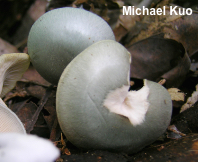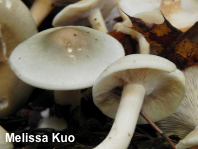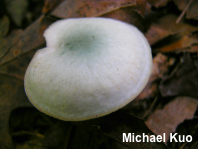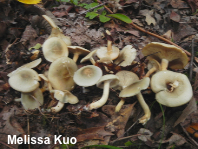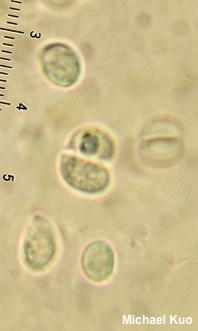| Major Groups > Gilled Mushrooms > Pale-Spored > Clitocyboid Mushrooms > Clitocybe odora |

|
Clitocybe odora [Basidiomycota > Agaricales > Tricholomataceae > Clitocybe . . . ] by Michael Kuo When fresh and unfaded, Clitocybe odora is a gorgeous shade of bluish green and smells strongly of anise (like black licorice or ouzo), making it fairly easy to recognize. However the striking green shades depicted in field guides can be ephemeral, and brownish caps with a slight greenish tinge are often encountered. The anise odor also fades as the mushrooms age, and older specimens sometimes lack the odor entirely. A variety from the Pacific Northwest, Clitocybe odora pacifica, has blue-green gills. Description: Ecology: Saprobic; growing scattered or gregariously on the litter of hardwoods or conifers; summer and fall; originally described from France; widespread in Europe; in North America widely distributed in northern and montane areas, as well as the Midwestern United States (but apparently rare or absent in the southeastern and southwestern United States); also reported from Japan. The illustrated and described collections are from Illinois. Cap: 2.5–7 cm; convex with an inrolled margin at first, becoming broadly convex to nearly flat; dry; bald or very finely innately fibrillose; blue-green to green when fresh and young, but fading quickly to brownish or even whitish, often with a darker center; the margin sometimes slightly lined at maturity. Gills: Attached to the stem or beginning to run down it; close or crowded; Short-gills frequent; whitish to faintly pinkish. Stem: 3–7 cm long; 5–12 mm thick; equal; dry; bald; whitish to brownish; with copious white mycelium at the base. Flesh: Thin; whitish; unchanging when sliced. Odor When fresh, strongly of anise. Chemical Reactions: KOH on cap surface erasing green to pale orange or yellowish. Spore Print: Whitish to creamy in a thin print; pinkish in a thick print. Microscopic Details: Spores 5–7 x 3–5 µm; ellipsoid; with a tiny apiculus; smooth; hyaline in KOH; inamyloid; often adhering in groups of 2–4. Basidia 25–34 x 5–7 µm; clavate; 4-sterigmate. Cystidia not found. Pileipellis a cutis of elements 5–12.5 µm wide, smooth, hyaline; clamp connections present. REFERENCES: (J. B. F. Bulliard, 1784) P. Kummer, 1871. (Fries, 1821; Saccardo, 1887; Kauffman, 1918; Harmaja, 1969; Smith, 1975; Harmaja, 1976; Smith, Smith & Weber, 1979; Phillips, 1981; Bigelow, 1982; Arora, 1986; Breitenbach & Kränzlin, 1991; Phillips, 1991/2005; Schalkwijk-Barendsen, 1991; Lincoff, 1992; Horn, Kay & Abel, 1993; Kuyper, 1995; Barron, 1999; McNeil, 2006; Miller & Miller, 2006; Gregory, 2007; Nonis, 2007; Buczacki et al., 2012; Kuo & Methven, 2014; Desjardin, Wood & Stevens, 2015; Siegel & Schwarz, 2016; Gminder & Böhning, 2017; Vesterholt, 2018; Læssøe & Petersen, 2019; McKnight et al., 2021.) Herb. Kuo 09109604, 10050501, 09231201. This site contains no information about the edibility or toxicity of mushrooms. |
© MushroomExpert.Com |
|
Cite this page as: Kuo, M. (2020, August). Clitocybe odora. Retrieved from the MushroomExpert.Com Web site: http://www.mushroomexpert.com/clitocybe_odora.html |
